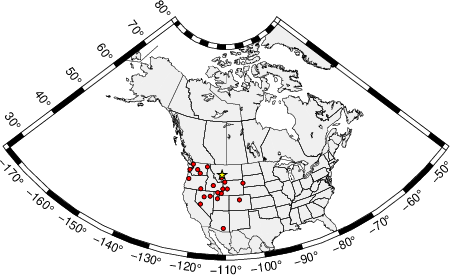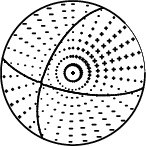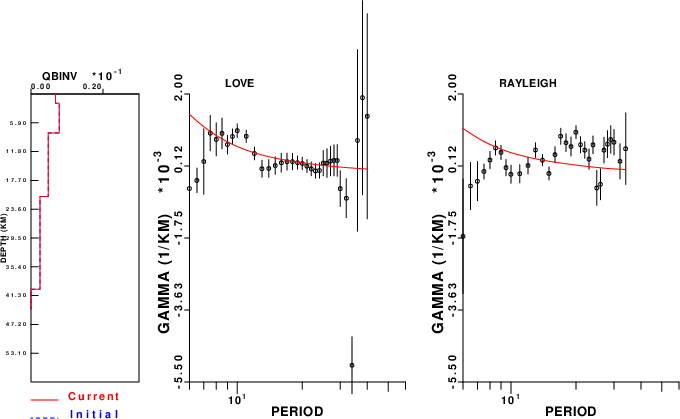
The ANSS event ID is usp0009r04 and the event page is at https://earthquake.usgs.gov/earthquakes/eventpage/usp0009r04/executive.
2000/04/08 11:30:21 46.342 -111.410 4.7 4.1 Montana
USGS/SLU Moment Tensor Solution
ENS 2000/04/08 11:30:21:0 46.34 -111.41 4.7 4.1 Montana
Stations used:
_.AHID _.BOZ _.BW06 _.HWUT _.LKWY
_.NEW
Filtering commands used:
cut o DIST/3.3 -40 o DIST/3.3 +50
rtr
taper w 0.1
hp c 0.03 n 3
lp c 0.07 n 3
br c 0.12 0.25 n 4 p 2
Best Fitting Double Couple
Mo = 3.39e+21 dyne-cm
Mw = 3.62
Z = 7 km
Plane Strike Dip Rake
NP1 281 85 -165
NP2 190 75 -5
Principal Axes:
Axis Value Plunge Azimuth
T 3.39e+21 7 55
N 0.00e+00 74 299
P -3.39e+21 14 147
Moment Tensor: (dyne-cm)
Component Value
Mxx -1.11e+21
Mxy 3.04e+21
Mxz 9.05e+20
Myy 1.26e+21
Myz -1.00e+20
Mzz -1.48e+20
----------####
-------------#########
---------------#############
---------------##############
----------------############### T
-----------------############### #
-----------------#####################
-----------------#######################
-----------------#######################
#############-----########################
#################------###################
#################--------------###########
#################---------------------####
###############-------------------------
###############-------------------------
##############------------------------
#############-----------------------
############----------------------
##########------------- ----
#########------------- P ---
#######------------
###-----------
Global CMT Convention Moment Tensor:
R T P
-1.48e+20 9.05e+20 1.00e+20
9.05e+20 -1.11e+21 -3.04e+21
1.00e+20 -3.04e+21 1.26e+21
Details of the solution is found at
http://www.eas.slu.edu/eqc/eqc_mt/MECH.NA/20000408113021/index.html
|
STK = 190
DIP = 75
RAKE = -5
MW = 3.62
HS = 7.0
The NDK file is 20000408113021.ndk The waveform inversion is preferred.
 |
The focal mechanism was determined using broadband seismic waveforms. The location of the event (star) and the stations used for (red) the waveform inversion are shown in the next figure.

|
|
|
The program wvfgrd96 was used with good traces observed at short distance to determine the focal mechanism, depth and seismic moment. This technique requires a high quality signal and well determined velocity model for the Green's functions. To the extent that these are the quality data, this type of mechanism should be preferred over the radiation pattern technique which requires the separate step of defining the pressure and tension quadrants and the correct strike.
The observed and predicted traces are filtered using the following gsac commands:
cut o DIST/3.3 -40 o DIST/3.3 +50 rtr taper w 0.1 hp c 0.03 n 3 lp c 0.07 n 3 br c 0.12 0.25 n 4 p 2The results of this grid search are as follow:
DEPTH STK DIP RAKE MW FIT
WVFGRD96 1.0 0 85 -10 3.38 0.3607
WVFGRD96 2.0 0 75 -20 3.52 0.5116
WVFGRD96 3.0 185 75 -10 3.55 0.5514
WVFGRD96 4.0 190 70 -5 3.58 0.5787
WVFGRD96 5.0 190 70 -5 3.60 0.5941
WVFGRD96 6.0 190 75 -5 3.61 0.6008
WVFGRD96 7.0 190 75 -5 3.62 0.6032
WVFGRD96 8.0 190 70 -10 3.65 0.6024
WVFGRD96 9.0 190 75 -10 3.66 0.6013
WVFGRD96 10.0 190 75 -15 3.67 0.5993
WVFGRD96 11.0 190 75 -15 3.68 0.5969
WVFGRD96 12.0 190 75 -15 3.69 0.5942
WVFGRD96 13.0 190 75 -15 3.70 0.5911
WVFGRD96 14.0 190 80 -20 3.72 0.5879
WVFGRD96 15.0 190 80 -20 3.72 0.5852
WVFGRD96 16.0 190 80 -20 3.73 0.5824
WVFGRD96 17.0 190 80 -20 3.74 0.5795
WVFGRD96 18.0 185 80 -25 3.75 0.5767
WVFGRD96 19.0 185 80 -25 3.76 0.5746
WVFGRD96 20.0 185 80 -25 3.77 0.5726
WVFGRD96 21.0 185 80 -30 3.79 0.5711
WVFGRD96 22.0 185 80 -30 3.80 0.5698
WVFGRD96 23.0 185 80 -30 3.80 0.5685
WVFGRD96 24.0 185 80 -35 3.82 0.5674
WVFGRD96 25.0 185 80 -35 3.83 0.5663
WVFGRD96 26.0 185 80 -40 3.86 0.5649
WVFGRD96 27.0 185 80 -40 3.87 0.5640
WVFGRD96 28.0 185 80 -40 3.87 0.5628
WVFGRD96 29.0 185 80 -40 3.88 0.5610
The best solution is
WVFGRD96 7.0 190 75 -5 3.62 0.6032
The mechanism corresponding to the best fit is

|
|
|
The best fit as a function of depth is given in the following figure:

|
|
|
The comparison of the observed and predicted waveforms is given in the next figure. The red traces are the observed and the blue are the predicted. Each observed-predicted component is plotted to the same scale and peak amplitudes are indicated by the numbers to the left of each trace. A pair of numbers is given in black at the right of each predicted traces. The upper number it the time shift required for maximum correlation between the observed and predicted traces. This time shift is required because the synthetics are not computed at exactly the same distance as the observed, the velocity model used in the predictions may not be perfect and the epicentral parameters may be be off. A positive time shift indicates that the prediction is too fast and should be delayed to match the observed trace (shift to the right in this figure). A negative value indicates that the prediction is too slow. The lower number gives the percentage of variance reduction to characterize the individual goodness of fit (100% indicates a perfect fit).
The bandpass filter used in the processing and for the display was
cut o DIST/3.3 -40 o DIST/3.3 +50 rtr taper w 0.1 hp c 0.03 n 3 lp c 0.07 n 3 br c 0.12 0.25 n 4 p 2

|
| Figure 3. Waveform comparison for selected depth. Red: observed; Blue - predicted. The time shift with respect to the model prediction is indicated. The percent of fit is also indicated. The time scale is relative to the first trace sample. |

|
| Focal mechanism sensitivity at the preferred depth. The red color indicates a very good fit to the waveforms. Each solution is plotted as a vector at a given value of strike and dip with the angle of the vector representing the rake angle, measured, with respect to the upward vertical (N) in the figure. |
A check on the assumed source location is possible by looking at the time shifts between the observed and predicted traces. The time shifts for waveform matching arise for several reasons:
Time_shift = A + B cos Azimuth + C Sin Azimuth
The time shifts for this inversion lead to the next figure:

The derived shift in origin time and epicentral coordinates are given at the bottom of the figure.
The following figure shows the stations used in the grid search for the best focal mechanism to fit the surface-wave spectral amplitudes of the Love and Rayleigh waves.

|
|
|
The surface-wave determined focal mechanism is shown here.
NODAL PLANES
STK= 101.87
DIP= 68.53
RAKE= 147.50
OR
STK= 204.99
DIP= 60.00
RAKE= 25.00
DEPTH = 7.0 km
Mw = 3.79
Best Fit 0.8567 - P-T axis plot gives solutions with FIT greater than FIT90
 |
Surface wave analysis was performed using codes from Computer Programs in Seismology, specifically the multiple filter analysis program do_mft and the surface-wave radiation pattern search program srfgrd96.
Digital data were collected, instrument response removed and traces converted
to Z, R an T components. Multiple filter analysis was applied to the Z and T traces to obtain the Rayleigh- and Love-wave spectral amplitudes, respectively.
These were input to the search program which examined all depths between 1 and 25 km
and all possible mechanisms.

|
|
|

|
| Pressure-tension axis trends. Since the surface-wave spectra search does not distinguish between P and T axes and since there is a 180 ambiguity in strike, all possible P and T axes are plotted. First motion data and waveforms will be used to select the preferred mechanism. The purpose of this plot is to provide an idea of the possible range of solutions. The P and T-axes for all mechanisms with goodness of fit greater than 0.9 FITMAX (above) are plotted here. |

|
| Focal mechanism sensitivity at the preferred depth. The red color indicates a very good fit to the Love and Rayleigh wave radiation patterns. Each solution is plotted as a vector at a given value of strike and dip with the angle of the vector representing the rake angle, measured, with respect to the upward vertical (N) in the figure. Because of the symmetry of the spectral amplitude rediation patterns, only strikes from 0-180 degrees are sampled. |

|

|
The WUS.model used for the waveform synthetic seismograms and for the surface wave eigenfunctions and dispersion is as follows (The format is in the model96 format of Computer Programs in Seismology).
MODEL.01
Model after 8 iterations
ISOTROPIC
KGS
FLAT EARTH
1-D
CONSTANT VELOCITY
LINE08
LINE09
LINE10
LINE11
H(KM) VP(KM/S) VS(KM/S) RHO(GM/CC) QP QS ETAP ETAS FREFP FREFS
1.9000 3.4065 2.0089 2.2150 0.302E-02 0.679E-02 0.00 0.00 1.00 1.00
6.1000 5.5445 3.2953 2.6089 0.349E-02 0.784E-02 0.00 0.00 1.00 1.00
13.0000 6.2708 3.7396 2.7812 0.212E-02 0.476E-02 0.00 0.00 1.00 1.00
19.0000 6.4075 3.7680 2.8223 0.111E-02 0.249E-02 0.00 0.00 1.00 1.00
0.0000 7.9000 4.6200 3.2760 0.164E-10 0.370E-10 0.00 0.00 1.00 1.00